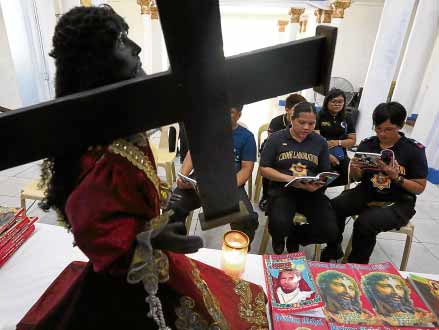
PABASA COPS Manila police investigators start the Pabasa ritual inside police headquarters. —MARIANNE BERMUDEZ
Adopting today’s popular tunes for Pabasa might just be the key to introducing the young to Philippine traditions during Holy Week, according to the committee on public affairs of the Catholic Bishops’ Conference of the Philippines.
Pabasa is the public reading of verses depicting the suffering of Christ before his crucifixion.
In Bulakan, Bulacan province, this year’s Pabasa was launched on April 7 by honoring the man who composed it for Filipino devotees.
The town also unveiled a monument in honor of Fr. Mariano Bernabe Pilapil, who composed the Filipino version of the Passion of Christ 203 years ago.
Fr. Jerome Secillano, executive secretary of the committee, said using contemporary tunes to chant the Passion of Jesus Christ just might attract young people to join their elders in Pabasa.
“That’s one way of attracting the young. If you’re going to stick to the traditional way, it’s just going to be the older folk. But we shouldn’t deprive the young of the experience,” Secillano said.
He added, “If using newer songs will actually attract the young to participate in Pabasa, much better.”
Pabasa is done during the Holy Week, in which two people or two groups of people take turn in reading the Pasyon.
The Catholic ritual is carried out day and night, spanning days and usually ends on Good Friday before Jesus Christ’s traditional death at
3 p.m. that day.
Contemporary tunes
In recent years, singers of Pabasa have taken to using contemporary tunes instead of the traditional ones in chanting the epic poem.
Secillano said the elders could also choose to let the young learn the traditional ways of Pabasa, stressing that there was also value in educating the young in the old ways.
“[But] some youths may not care for that. So we go back to that, maybe it becomes more appealing to the young if the chant would be attuned to the new songs that we have right now,” he said.
What is important is that the young faithful are encouraged and attracted to pray and participate in the observance of the Lenten season, which culminates in the Holy Week, he said.
Diocese of Malolos
“The Pasyon tells us the history of our salvation and it’s a form of prayer. We learn that there is a God who created us, who saved us and you should not forsake him,” Secillano said.
Pabasa in Bulakan was sponsored for the first time by the Diocese of Malolos, said Msgr. Andres Valera, consultant to the Commission on Liturgy and a professor of liturgy and popular religiosity.
Valera said Pilapil wrote “Pasyong Mahal ni Kristo” (The Passion of Christ), or simply Pasyon, in 1814, by gathering everything from the Bible about the life and death of Christ and accounts by unknown authors.
“Father Pilapil wrote Tagalog verses, which we continue to recite or sing during Holy Week,” Valera said. Pilapil’s version was also known as “Pasyong Pilapil.”
Pilapil’s collaborator
Fr. Amador Wisco Cruz, who used to serve as parish priest of Makinabang Church in Baliuag town, was Pilapil’s collaborator in writing the Pasyon. Cruz translated the Latin words in the original Passion of Christ.
Joey Rodrigo, Bulakan tourism officer, said the parish church of Nuestra Señora de la Asuncion in the town conducted Pabasa on “Viernes Dolores” (the Friday before Palm Sunday).
28 ways
The Diocesan Grand Pabasa sponsored by the diocese featured 28 ways to recite the verses written by Pilapil.
The recitation or chanting of the verses were expressed using various tunes. Some of the chanters preferred a classical rendering of the verses. One recitation was expressed as a lamentation.
Pilapil was born in this town in 1756 and was acclaimed for his religiosity and intellectual pursuits. He was fluent in Spanish, Latin and Tagalog.
He completed his studies at the University of Santo Tomas and was assigned to Bacoor Church from 1794 to 1795 before he served as rector of Colegio Real de San Jose.
He taught lessons about Filipino poet Francisco Balagtas. He also authored “Gramatica Hispano-Latina.”